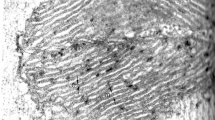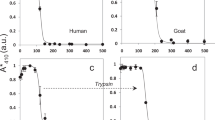Abstract
MANY products of catecholamine metabolism have been identified, but the metabolic fate of epinephrine and norepinephrine has remained virtually unknown1,2. In the investigation reported here, the presence of added epinephrine and norepinephrine in red cells in vitro was determined by means of their reaction with the intracellular non-protein sulphydryl group. To measure the sulphydryl group within erythrocytes the intracellular protein was first denatured by the addition of trichloroacetic acid3,4. Epinephrine within the cells reacted with and decreased the concentration of the free non-protein sulphydryl group with the aid of oxygen liberated during the denaturation of oxyhaemoglobin, while extracellular catecholamine was unreactive. The results indicated that entrance into human erythrocytes was a possible pathway for catecholamine metabolism.
This is a preview of subscription content, access via your institution
Access options
Subscribe to this journal
Receive 51 print issues and online access
$199.00 per year
only $3.90 per issue
Buy this article
- Purchase on Springer Link
- Instant access to full article PDF
Prices may be subject to local taxes which are calculated during checkout
Similar content being viewed by others
References
Goodall, McC., and Rosen, L., J. Clin. Invest., 42, 1578 (1963).
Axelrod, J., Weil-Malherbe, H., and Tomchick, R., J. Pharmacol. and Exp. Therap., 127, 251 (1959).
Roston, S., Nature, 203, 1075 (1964).
Roston, S., Arch. Biochem. Biophys., 109, 41 (1965).
Parpart, A. K., Lorenz, P. B., Parpart, E. R., Gregg, J. R., and Chase, A. M., J. Clin. Invest., 26, 636 (1947).
Kassan, R. J., and Roe, J. H., J. Biol. Chem., 133, 579 (1940).
Cahen, A., Compt. Rend. Soc. Biol., 127, 221 (1938).
Numata, I., Biochem. Z., 304, 404 (1940).
Blum, J. J., and Ling, N.-S., Biochem. J., 73, 530 (1959).
Lemberg, R., and Legge, J. W., Hematin Compounds and Bile Pigments, 395, 396, 517 (Interscience Publishers, Inc., New York, 1949).
Rodnight, R., J. Physiol., 141, 10 (1958).
Zaimis, E., Ann. Rev. Pharm., 4, 375 (1965).
Author information
Authors and Affiliations
Rights and permissions
About this article
Cite this article
ROSTON, S. Entrance of Epinephrine into the Human Erythrocyte. Nature 212, 1380–1381 (1966). https://doi.org/10.1038/2121380a0
Issue Date:
DOI: https://doi.org/10.1038/2121380a0
This article is cited by
-
Die Permeation von Isoproterenol durch die Erythrocytenmembran des Menschen
Klinische Wochenschrift (1970)
-
Rapid Movement of Epinephrine and Norepinephrine into Human Erythrocytes
Nature (1967)
Comments
By submitting a comment you agree to abide by our Terms and Community Guidelines. If you find something abusive or that does not comply with our terms or guidelines please flag it as inappropriate.



